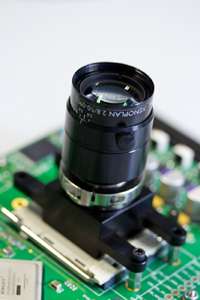Imec’s prototype camera with imec’s hyperspectral sensor.
At SPIE Photonics West 2012, imec demonstrates a hyperspectral camera solution based on a system-on-chip image sensor with an integrated hyperspectral sensor. Imec’s solution is fast and enables small and cost-efficient camera-solutions. It targets multiple industrial vision applications.
Hyperspectral cameras combine spectroscopy and imaging, and by doing this, they can e.g. discriminate between different objects that cannot be accurately distinguished using traditional RGB (red-green-blue) imaging methods. The technology can be very useful in many application domains such as crop screening, food selection, skin cancer detection, target detection, .... However, the currently available hyperspectral cameras are large, expensive and slow. Therefore, they can often not be used for time-critical or high-throughput applications, and their use is thus limited to highly specialized research environments. Imec’s chip-based technology paves the way towards the industrial application of hyperspectral imaging, as it enables small, cost-efficient and fast solutions.
Imec’s fully integrated CMOS compatible hyperspectral sensor, today presented at SPIE Photonics West 2012, consists of a set of spectral filters that are directly post-processed at wafer level on top of a commercially available CMOSIS CMV4000 image sensor (a 4 megapixel sensor with a maximum framerate of 180fps). The hyperspectral filter, developed at imec, has100 spectral bands between 560nm and 1000nm. The filter bandwidth (Full Width Half Max) ranges from 3nm at 560nm to 20nm at 1000nm, and the transmission efficiency of the filters is around 85%. Typical integration times used in the current prototype setup are between 2 and 10 miliseconds under halogen light illumination of 450 Watt. This indicates maximal frame rates can be achieved of up to 500fp.
Due to its integrated filter design and high spectral filter efficiency, imec’s solution can obtain scanning speeds that are compatible with real industrial requirements. The speed of the demonstrated system corresponds to an equivalent speed of 2,000 lines per second, significantly exceeding current state-of-the-art hyperspectral sensors. Moreover, imec’s technology can be adopted to a range of industrial vision applications. To match to specific application requirements, the image sensor can be selected (a commercially available sensor or even a custom-designed sensor), determining pixels sizes, maximal frame rate, etc. The hyperspectral filter can be tuned by changing the number of spectral bands and their spectral resolution.
Imec’s prototype hyperspectral camera can capture all relevant data enabling automatic classification of different objects using state-of-the-art image processing methods. Classification results of imec’s solution are equivalent to state-of-the-art hyperspectral references and recorded spectra of e.g. plant material.
Provided by IMEC




















